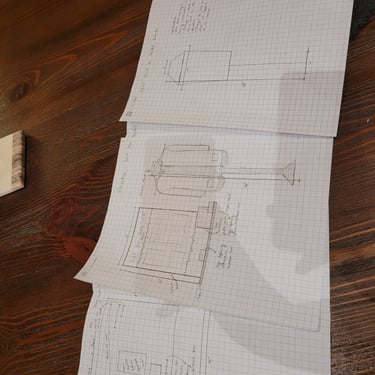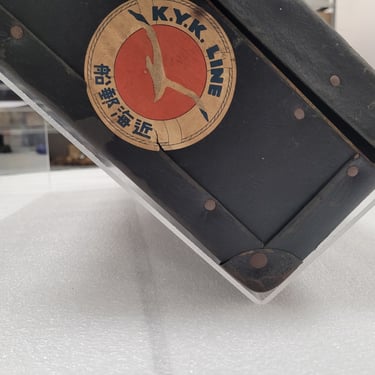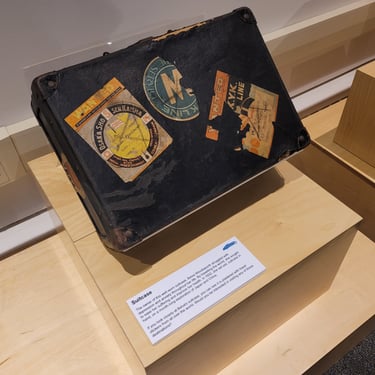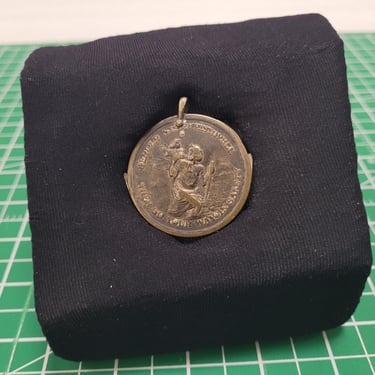

Housekeeping
Spring cleaning can happen any time of the year, especially if it’s to help conserve a museum’s collection. The Peterborough Museum and Archives has an active and ongoing partnership with the Museum Management program at Fleming College, and as a result, students like me have the opportunity to learn practical skills while also helping the museum take care of their collection.
While cleaning one of the aisles in the PMA, I came across many artifacts that required different methods of cleaning. With these typewriters for instance using a brush to sweep dust into a cloth-covered vacuum nozzle was the best way to clean in. Cleaning with the vacuum hose draped over one’s shoulder distributes and controls the weight evenly. Just a shelf over, using a cloth to wipe down glass display cases was ideal.
Doing regular cleanings of the collection is not only great for the upkeep of the artifacts, but it allows for a regular check-up of artifacts as well. When we were doing this clean, my partner and I discovered a metal box that was heavily rusted. We were able to notify the conservator of the condition of this box. With cleaning exercises like this, we were able to catch the box in this state and hopefully prevent it from worsening. To clean this, we lightly brushed the rust off into the covered nozzle.
Brushing dust off of typewriter keys into a vacuum.


Rehousing
The three-year PMA artifact rehousing project concluded this month as we worked through the final boxes of artifacts. Since their excavation, many of the objects had been housed in temporary conditions, padded only with paper towels or tissue. Our task was to examine our box of artifacts and work on a solution to rehouse them according to museum standards and preventive conservation measures.
I was assigned a box with thirteen glass Gin bottles. The bottles were in good condition. Most had a rainbow effect, a sign of delamination in glass objects. Some had some residue on the glass.
Removing bottles from the storage box to examine them.
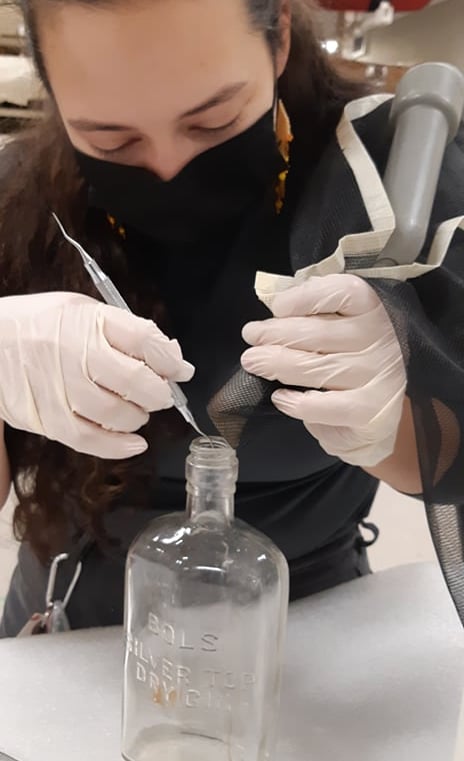

Removing moth nest.

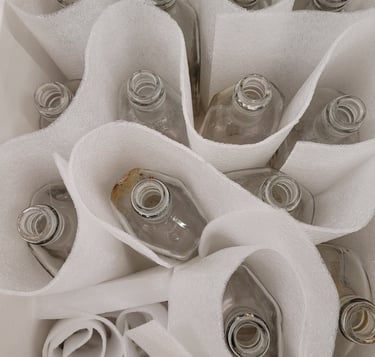
Final Configuration.
After removing the bottles from the box, I discovered a moth at the bottom. It was dead and there were no signs of others. This was a point in favour of regular housekeeping and preventive conservation. Thankfully moths and other pests can’t eat glass, discovering more in the box could have been hazardous to the rest of the collection. Thankfully this wasn’t the case. I then discovered the moth’s nest in one of the bottlenecks. With a small metal pick, screen and vacuum, I was able to loosen the nest fibres and remove them from the bottle.
Finally, I had to figure out the configuration of the bottles in the box. Adding the Ethafoam is a great support and prevents the glass bottles from hitting each other, but takes up a lot of space. At first, I laid them in the box horizontally, making sure the ethafoam sheet separated each bottle and layer. This took up too much space and I stood them upright instead to use up all the space in the box. I padded out the extra space in the box.
This rehousing project was an important task to undertake as a way to conserve the archaeological collection for future use and study.


Winterizing
In November 2021, our class visited Lang Pioneer Village to help them prepare some of their heritage buildings to close for the winter. Tasks included sweeping and dusting, removing proteinaceous materials like woollen blankets and candles, and removing seasonal items for off-season storage.
In the Fitzpatrick House, my team and I swept both the top and bottom floors and collected debris which was quickly tossed outside. Proteinaceous materials were stored in a plastic box to be brought to a larger storage facility over the winter. Textile and clothing items were also stored in bags. This is important as pests like rodents or bugs are attracted to the edible nature of these materials, protecting them over less supervised winter months is essential to avoid tempting infestation as well as for preventive conservation purposes.
Sweeping in Fitzpatrick House.


Reconstruction Project
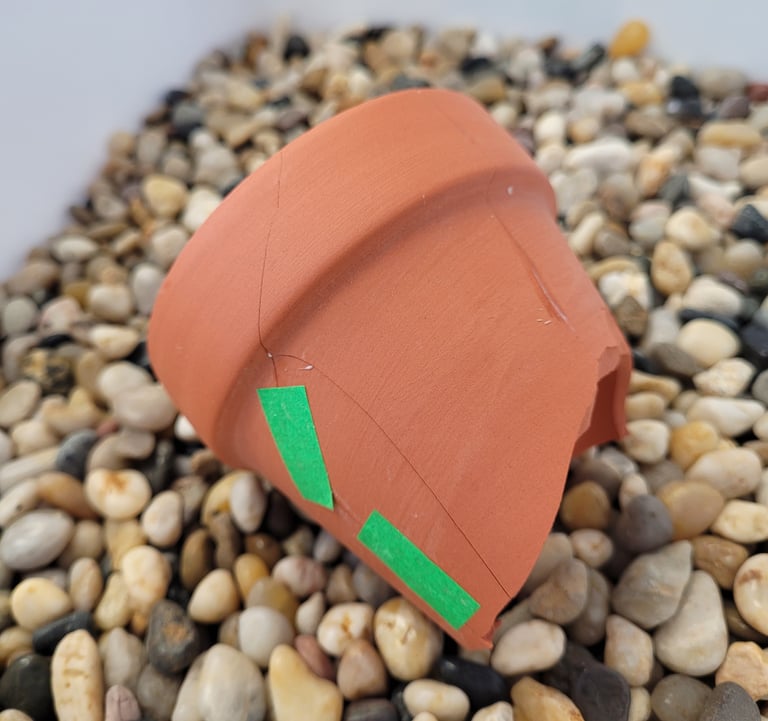

This was a workshop we did as a class one afternoon. The goal was to break a flower pot, then create a plan for how to reassemble the pieces. It's important to plan this out in advance as the more the edges of the pieces rub against each other, the more they lose their shape, resulting in a puzzle where none of the pieces quite fit together. Using water-soluble adhesives and low tac tape, I reattached the shards until the pot was back in one piece. The result is a slightly Frankenstein flower pot, but in one piece and show-room ready.
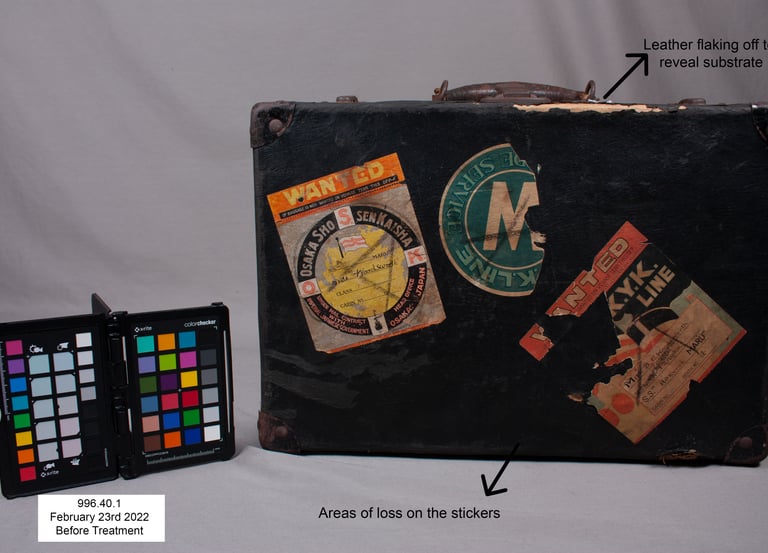

Condition Reports
An essential aspect of working with artifacts is being able to create a condition report. I have been able to create and update documents of this nature through the Fleming College partnership with the Peterborough Museum and Archives as well as through various volunteer positions and other projects. Taking and annotating images of the artifact in question is also an essential element to the documentation process, especially if the artifact goes for treatment at a later date.
Mount Making
It is not uncommon to have to create a unique mount for artifacts going on display. Each object varies in shape and size, and most specifically structural strength. Each needs support in the weakest areas, a mount that doesn't distract from the object on display and one that will provide good support.
Before construction, a detailed plan has to be created. Some objects, like the duck sweater for my mini exhibit, required a mount that I couldn't make myself - a mannequin. The objects I am handling for the Home and Away exhibit required specific mounts that I made according to my plans. For the suitcase, I cut and bent a sheet of plexiglass to create a stable mount. The angled display allows visitors a better look at the stickers on the surface of the case. For the medallion, I carved a block of ethafoam and covered it in stockinette before setting in the medallion. Again, the angled surface allows for a better view of the details on the medallion.
